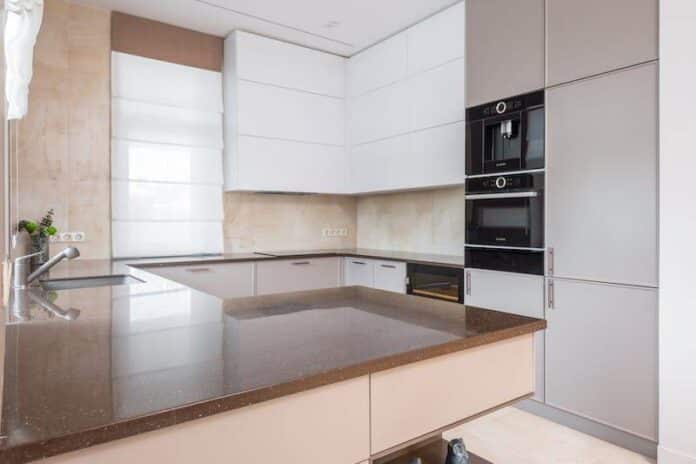
Selecting the right natural stone benchtops for your kitchen involves considering both the aesthetic appeal and the functional demands of your space.
This comprehensive guide aims to navigate you through the process, ensuring you make an informed decision that enhances the beauty and efficiency of your kitchen.
Factors to Consider Before Selecting Natural Stone Benchtops
Before you settle on a specific type of natural stone for your kitchen benchtops, it’s vital to take into account several key factors that could significantly influence your choice:
- Durability and Usage: The kitchen is often the heart of the home, subjected to spills, cuts, heat, and more. Opt for stones like granite or quartz that are known for their durability and resistance to wear and tear. This is particularly important if your kitchen sees a lot of action, from cooking to entertaining.
- Maintenance and Care: Some natural stones require more maintenance than others. Marble, for instance, is porous and prone to staining if not sealed properly, requiring more attention than quartz, which is virtually maintenance-free due to its non-porous nature.
- Aesthetic Compatibility: The natural stone you choose should complement the overall design of your kitchen. From sleek and modern to warm and traditional, make sure the texture, color, and style of the stone align with your kitchen’s aesthetic, including cabinetry and stone splashbacks for kitchens.
- Budget Considerations: The cost of natural stone benchtops can vary widely. While marble and granite might be on the higher end of the spectrum, options like soapstone and limestone can offer a more budget-friendly alternative without compromising on quality and appearance.
- Heat and Stain Resistance: Kitchens are prone to messes and high temperatures. Materials like granite offer excellent heat resistance, making it safe to place hot pots directly on the surface without damage. For those concerned about stains, quartz might be a better option due to its non-porous nature.
6 Tips to Choose the Best Natural Stone Benchtops for Your Kitchen
Selecting the perfect natural stone benchtops for your kitchen is a critical decision that impacts both the aesthetic appeal and functionality of your space. With the myriad of options available in the market, it’s essential to navigate this selection process wisely to ensure your kitchen not only looks stunning but also caters to your practical needs.
- Consider Your Kitchen’s Daily Activity: Evaluate the level of activity your kitchen usually sees. For high-traffic kitchens, granite and quartz are top contenders for their resilience against scratches, stains, and heat, making them ideal for avid cooks or families.
- Harmonize With Your Kitchen’s Design: Whether you’re aiming for a rustic feel or a modern look, the right natural stone can significantly impact your kitchen’s aesthetic. Marble, with its unique veining, adds elegance, while soapstone offers a more subdued, matte finish for a natural look.
- Be Mindful of Maintenance Needs: If a low-maintenance countertop appeals to you, quartz is a standout choice due to its ease of cleaning and resistance to staining. Natural stones like granite require sealing but offer stunning, unique patterns and robustness.
- Align With Your Color Scheme: The color of your benchtop should enhance the overall palette of your kitchen. Natural stone offers a spectrum of hues, from the deep, rich tones of granite to the soft, subtle shades of marble. Consider the color of your stone splashbacks for kitchens when choosing.
- Select the Right Finish: The finish of your benchtop can influence both its look and functionality. A polished finish is glossy and reflective, while honed and leathered finishes offer a more matte appearance that can hide scratches and fingerprints.
- Factor In the Long-Term Value: Investing in a high-quality natural stone benchtop can add value to your home. Consider not just the initial cost but also the longevity and durability of the stone, ensuring it remains a beautiful and functional part of your kitchen for years to come.
How to Clean & Maintain Your Natural Stone Benchtops
Proper care and maintenance can extend the life of your natural stone benchtops, keeping them looking as stunning as the day they were installed:
- Daily Cleaning Routine: For everyday cleaning, use a soft cloth and a mild detergent. This simple routine can prevent stains and keep your benchtops looking pristine.
- Immediate Spill Cleanup: Natural stone can be porous, making it important to wipe up spills immediately, especially acidic substances that could etch the surface.
- Use of Protective Mats and Trivets: Protect your natural stone benchtops from heat and potential scratches by using mats or trivets under hot pans and sharp objects.
- Regular Sealing: Depending on the type of stone, sealing may be required periodically to protect against staining. Consult with your supplier for the recommended sealing frequency for your specific benchtop material.
- Avoid Harsh Chemicals: Harsh chemicals can damage the surface of natural stone. Stick to cleaners specifically formulated for use on natural stone to avoid any potential harm.
FAQs
What is the best natural stone for kitchen benchtops?
Granite and quartz stand out for their durability, ease of maintenance, and aesthetic versatility, making them popular choices for kitchen benchtops.
How do I choose a stone for my benchtop?
Assess your lifestyle, kitchen activity level, aesthetic preferences, maintenance willingness, and budget. Sampling the stone in your kitchen environment can also help make the decision easier.
What is the safest kitchen benchtop?
Quartz is often considered the safest option due to its non-porous surface, minimizing the risk of bacteria growth and making it easy to clean and maintain.
How to choose kitchen benchtop colour?
Consider the overall colour scheme of your kitchen, including cabinetry, flooring, and stone splashbacks for kitchens. Look for a colour that complements or pleasantly contrasts with your existing decor.

